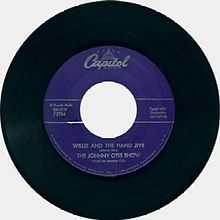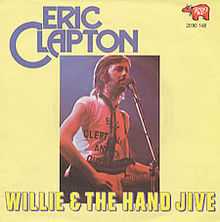Willie and the Hand Jive
| "Willie and the Hand Jive" | |
|---|---|
 | |
| Single by Johnny Otis | |
| Released | 1958 |
| Format | 7" |
| Recorded | 1958 |
| Genre | Rock and roll |
| Label | Capitol |
| Writer(s) | Johnny Otis |
| "Willie and the Hand Jive" | ||||
|---|---|---|---|---|
 | ||||
| Single by Eric Clapton | ||||
| from the album 461 Ocean Boulevard | ||||
| B-side | "Mainline Florida" | |||
| Released | 1974 | |||
| Format | 7" | |||
| Recorded | 1974 | |||
| Genre | Blues, rock | |||
| Length | 3:31 | |||
| Label | RSO | |||
| Writer(s) | Johnny Otis | |||
| Producer(s) | Tom Dowd | |||
| Eric Clapton singles chronology | ||||
| ||||
"Willie and the Hand Jive" is a song written by Johnny Otis and originally released as a single in 1958 by Johnny Otis Show, reaching #9 on the Billboard Hot 100 chart and #5 on the Billboard R&B chart.[1][2] The song has a Bo Diddley beat and was partly inspired by the music sung by a chain gang Otis heard while he was touring. The lyrics are about a man who became famous for doing a dance with his hands, but the song has been accused of glorifying masturbation. It has since been covered by numerous artists, including The Strangeloves, Eric Clapton, Cliff Richard, Kim Carnes, Johnny Rivers, George Thorogood and The Grateful Dead.[3][4] Clapton's 1974 version was also released as a single and also reached the Billboard Top 40, peaking at #26. Thorogood's 1985 version reached #25 on the Hot Mainstream Rock Tracks chart.
Lyrics and music
The Johnny Otis Show original version of the song produced by Tom Morgan has an infectious Bo Diddley beat,[1][2] much of it provided by drummer Earl Palmer.[5] Johnny Otis biographer George Lipsitz describes Jimmy Nolen's guitar riff on the song as "unforgettable".[2] The music was based on a song Otis had heard a chain gang singing while touring, combined with work Otis did as a teenager when he was performing with Count Otis Matthews and the West Oakland House Stompers.[2]
The lyrics tell of a man named Willie who became famous for doing a hand jive dance.[1][2] In a sense, the story is similar to that of Chuck Berry's "Johnny B. Goode", which tells of someone who became famous for playing the guitar and was released two months before "Willie and the Hand Jive".[1] The origin of the song came when one of Otis' managers, Hal Ziegler, found out that rock'n'roll concert venues in England did not permit the teenagers to stand up and dance in the aisles, so they instead danced with their hands while remaining in their seats.[2][4] At Otis' concerts, performers would demonstrate Willie's "hand jive" dance to the audience, so the audience could dance along.[2] The dance consisted of clapping two fists together one on top of the other, followed by rolling the arms around each other.[2] Otis' label, Capitol Records, also provided diagrams showing how to do the hand jive dance.[4]
Despite the song's references to dancing, and despite the demonstrations of the dance during performances, would-be censors believed that the song glorified masturbation.[2] As recently as 1992, an interviewer for NPR asked Otis "Is 'Hand Jive' really about masturbation?"[2][6] Otis was frustrated by this misinterpretation.[6]
Cover versions
In the 1960s, Cliff Richard covered the song in 1960 and The Strangeloves covered the song on their 1965 album I Want Candy.[7][8] Johnny Rivers covered the song on his 1973 album Blue Suede Shoes.[9]
Eric Clapton covered "Willie and the Hand Jive" for his 1974 album 461 Ocean Boulevard. Clapton slowed down the tempo for his version.[10] Author Chris Welch believes that the song benefits from this "slow burn".[10] However, Rolling Stone critic Ken Emerson complains that the song sounds "disconcertingly mournful".[11] Other critics praised Clapton's confident vocals.[12] Author Marc Roberty claimed that on this song, "Eric's vocals had clearly matured, with fluctuations and intonations that were convincing rather than tentative as in the past."[13] Clapton's version of the song was released as a single in 1974 and reached #26 on the Billboard Hot 100 and #28 in the Netherlands.[14][15] Clapton included the song on his compilation album Time Pieces: Best of Eric Clapton.[16] Clapton often played the song live, and it appeared on the live DVD One Night Only Live.[13][17] Author Harry Shapiro said that the song could sound like "a dirge on bad nights but uplifting when the mood was right".[18] Music author Dave Thompson claimed that Clapton's "live versions almost get you learning the [hand jive] movements all over again."[19]
George Thorogood recorded a version of "Willie and the Hand Jive" for his 1985 album with the Destroyers Maverick.[20] His single version charted on the Hot Mainstream Rock Tracks chart, peaking at #25, and reached #63 on the Billboard Hot 100 chart.[1][21] Allmusic critic James Christopher Monger called the song one of Thorogood's "high points."[22] Thorogood included the song on his 2000 compilation album Anthology, his 2002 compilation album On Tap Plus, his 2003 compilation album The George Thorogood Collection and his 2008 compilation The Best of George Thorogood & the Destroyers.[23][24][25][26]
Other artists who covered the song include New Riders of the Purple Sage, The Flying Burrito Brothers, Sandy Nelson, The Tremeloes, Amos Garrett, Ducks Deluxe and Levon Helm.[3] The Grateful Dead played "Willie and the Hand Jive" live several times in 1986 and 1987.[4]
Soundtracks
Footage from Otis' performance of "Willie and the Hand Jive" at the 1970 Monterey Jazz Festival was included in Clint Eastwood's 1971 film Play Misty for Me.[2][27]
This song can be heard in The Shawshank Redemption.
References
- ↑ 1.0 1.1 1.2 1.3 1.4 Dean, M. (2003). Rock 'n' roll: Gold rush : a singles un-encyclopedia. Algora Publishing. pp. 330, 429. ISBN 978-0-87586-207-1.
- ↑ 2.0 2.1 2.2 2.3 2.4 2.5 2.6 2.7 2.8 2.9 2.10 Lipsitz, G. (2010). Midnight at the Barrelhouse: the Johnny Otis story. University of Minnesota Press. pp. xxviii–xxix, 68–69, 93, 116. ISBN 978-0-8166-6679-9.
- ↑ 3.0 3.1 "Willie and the Hand Jive". Allmusic. Retrieved 2012-01-21.
- ↑ 4.0 4.1 4.2 4.3 Trager, O. (1997). The American book of the Dead: the definitive Grateful Dead encyclopedia. Simon & Schuster. p. 407. ISBN 978-0-684-81402-5.
- ↑ Scherman, Tony, Backbeat: The Earl Palmer Story, forward by Wynton Marsalis, Smithsonian Institute Press, Washington D.C., 1999
- ↑ 6.0 6.1 Otis, J. (1993). Upside your head!: rhythm and blues on Central Avenue. Wesleyan University Press. p. 62. ISBN 978-0-8195-6287-6.
- ↑ "Best Selling Pop Records in Britain". Billboard Magazine. April 4, 1960. p. 4.
- ↑ Planer, L. "I Want Candy: The Best of the Strangeloves". Allmusic. Retrieved 2012-01-21.
- ↑ Eder, B. "Blue Suede Shoes". Allmusic. Retrieved 2012-01-21.
- ↑ 10.0 10.1 Welch, C. (2011). Clapton: The Ultimate Illustrated History. Voyageur Press. p. 175. ISBN 978-0-7603-4046-2.
- ↑ Emerson, K. "461 Ocean Boulevard". Rolling Stone. Retrieved 2012-01-21.
- ↑ Schumacher, M. (2003). Crossroads: The Life and Music of Eric Clapton. Citadel Press. p. 181. ISBN 978-0-8065-2466-5.
- ↑ 13.0 13.1 Roberty, M. (1995). The Complete Guide to the Music of Eric Clapton. Omnibus Press. p. 72. ISBN 0-7119-4305-2.
- ↑ "461 Ocean Boulevard Charts & Awards". Allmusic. Retrieved 2012-01-21.
- ↑ "Willie and the Hand Jive". Hung Medien. Retrieved 2012-01-21.
- ↑ "Time Pieces: Best of Eric Clapton". Allmusic. Retrieved 2012-01-21.
- ↑ "One Night Only Live". Allmusic. Retrieved 2012-01-21.
- ↑ Shapiro, H. (1992). Eric Clapton: lost in the blues. Da Capo Press. p. 135. ISBN 978-0-306-80480-9.
- ↑ Thompson, D. (2011). 1000 Songs that Rock Your World. Krause Publications. p. 283. ISBN 978-1-4402-1422-6.
- ↑ Viglione, J. "Maverick". Allmusic. Retrieved 2012-01-21.
- ↑ "George Thorogood Billboard Singles". Allmusic. Retrieved 2012-01-21.
- ↑ Monger, J.C. "Platinum". Allmusic. Retrieved 2012-01-21.
- ↑ Horowitz, H. "Anthology". Allmusic. Retrieved 2012-01-21.
- ↑ "On Tap Plus". Allmusic. Retrieved 2012-01-21.
- ↑ "The Collection". Allmusic. Retrieved 2012-01-21.
- ↑ Sendra, T. "The Best of George Thorogood & the Destroyers". Allmusic. Retrieved 2012-01-21.
- ↑ "Play Misty for Me Soundtrack". Internet Movie Database. Retrieved 2012-01-21.